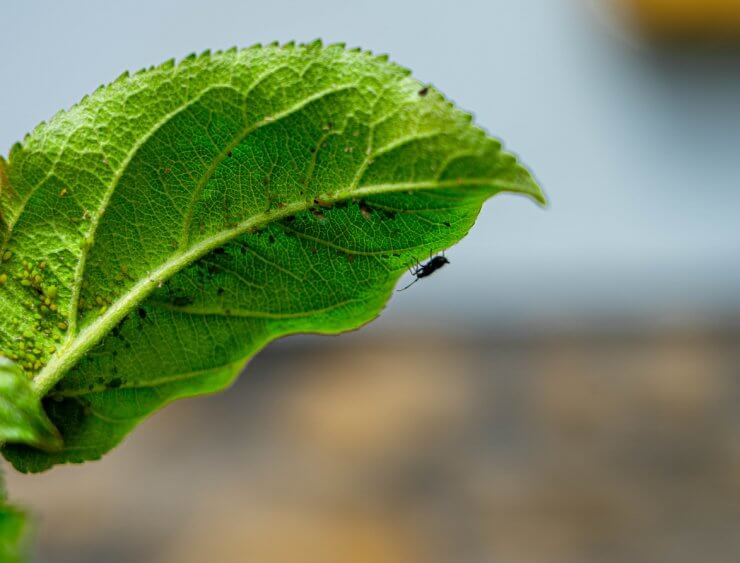
Aphids on apple tree leaf
Pests on your apple trees, left unchecked, can damage and destroy your crop and even your trees. Keeping a close watch on your trees during regular daily inspections will help you spot any pests before they can do irreparable harm. Healthy apple trees can bounce back from pest damage if you catch the pests quickly.
Spot the symptoms of apple tree pests
Check trunk, branches, leaves, and fruit for these symptoms that come from pests on the prowl.
On Apple Trunk, Branches and Leaves
| Symptom | Pest |
| Decimation of leaves, except for the large veins | Yellownecked Caterpillar, Gypsy Moth Caterpillar |
| Winding trail scars on the underside of leaves; white or red spots on the upper leaf surface | Spotted Tentiform Leafminer, Apple Leafminer |
| Tiny eggs on bark; yellowing, curling leaves; clusters of small “bumps” on underside of leaves; whitish, wooly clusters | Aphids, especially the Rosy Apple Aphid or Wooly Apple Aphid |
| Rolled leaves | Obliquebanded Leafroller |
| Brown to bronze leaves; fruit drop; bright red or translucent eggs on bark | European Red Mite |
| Leaves speckled or mottled with white spots where leaf tissue has been destroyed | White Apple Leafhopper |
| Honeydew on leaves | Spotted Lanternfly |
| Pale patches on leaves leading to leaf edge; leaves curling downward | Potato Leafhopper |
On Apple Fruit
| Symptom | Pest |
| Pitting and dimpling on apple skin; brown, winding trails on apple skin; apple drop | Apple Maggot |
| Ribbonlike scar on apple skin | European Apple Sawfly |
| TCrescent-shaped cuts or small round holes in skin | Plum Curculio |
| Tunneling from the side or base (calyx) of the apple to the core; pinprick-sized holes in skin | Codling Moth larvae |
How to treat pests on apple trees
Here are some proven ways to get rid of pests on your apple trees. Choose the best treatment for the type of pests invading your trees.
- Pick off the pests. Use your garden gloves to remove the pests by hand. After removal, destroy pests by drowning them in a bucket of soapy water or crushing them with your foot. Handpicking isn’t efficient or practical for very small pests, but works well with larger pests.
- Remove overripe, damaged, or deformed fruit. For the most part, apples stay fresh on the tree until you pick them. But if you notice any deformed fruit or fruit that look like it’s rotting on the tree, remove it as soon as possible. Rotting fruit can attract pests that further damage your tree or cause disease. Be sure to remove any fallen fruit; it fell for a reason. Chances are it’s now host to a pest that’s worked its way inside.
- Apply insecticidal soap. Insecticidal soap is organic. The potassium salts in insecticidal soap help remove an insect’s protective waxes, causing destruction of insect membranes and killing them. Mix the soap with water to create your solution, and apply directly to insects on any plants. While insecticidal soap is less apt to affect other organisms, certain plants might be sensitive to the soap and can suffer leaf burn.
- Apply horticultural oils. Combine plant- or petroleum-based oils with water to produce horticultural sprays. Neem oil, for instance, is derived from seed extracts of the neem plant. Oil-based sprays block an insect’s air holes, interfere with an insect’s metabolism, disrupt insect feeding, and inhibit insect growth. Like insecticidal soaps, horticultural oils can cause plant injury if not properly diluted.
- Make your own pest spray. You can make your own pest spray with benign materials. Mix 1 tablespoon of baking soda, 1/2 teaspoon of a mild dish detergent, and 2 1/2 tablespoons of olive oil in a gallon of water to make a solution that will repel all kinds of bugs, as well as a fungicide for blight and mildew on apple tree leaves. Shake it well in your bottle before spraying and repeat every week for it to be continuously effective.
- If your tree is infested, act quickly. If you discover that your apple tree is infested with anything, removed all infested/infected material—leaves, branches, and fruit. Make sure you get every single insect off your tree, then treat it thoroughly with a horticultural oil or neem oil.
Do pests attack your apple trees every year? How do you handle removing them—and even preventing them in the first place? Please tell us how you treat your apple trees to avoid pests.


 Previous
Previous


Big problem with yellow jackets in apple tree in ND. The yellow jackets destroy all the apples. What can I do?
Earwigs seem a major problem and not sure how to stop them. Use a need oil spray as blossoms falling off, and then every 3-4 weeks depending on wind & weather.